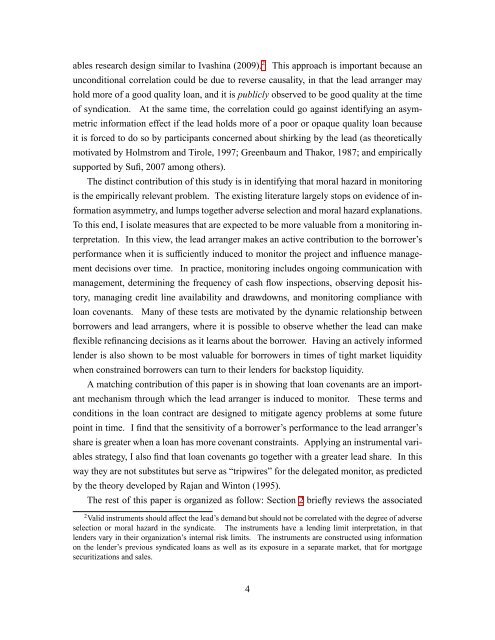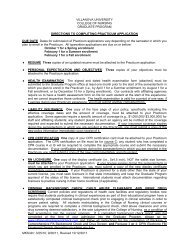Lender Exposure and Effort in the Syndicated Loan Market.pdf
Lender Exposure and Effort in the Syndicated Loan Market.pdf
Lender Exposure and Effort in the Syndicated Loan Market.pdf
You also want an ePaper? Increase the reach of your titles
YUMPU automatically turns print PDFs into web optimized ePapers that Google loves.
ables research design similar to Ivash<strong>in</strong>a (2009). 2This approach is important because anunconditional correlation could be due to reverse causality, <strong>in</strong> that <strong>the</strong> lead arranger mayhold more of a good quality loan, <strong>and</strong> it is publicly observed to be good quality at <strong>the</strong> timeof syndication.At <strong>the</strong> same time, <strong>the</strong> correlation could go aga<strong>in</strong>st identify<strong>in</strong>g an asymmetric<strong>in</strong>formation effect if <strong>the</strong> lead holds more of a poor or opaque quality loan becauseit is forced to do so by participants concerned about shirk<strong>in</strong>g by <strong>the</strong> lead (as <strong>the</strong>oreticallymotivated by Holmstrom <strong>and</strong> Tirole, 1997; Greenbaum <strong>and</strong> Thakor, 1987; <strong>and</strong> empiricallysupported by Su, 2007 among o<strong>the</strong>rs).The dist<strong>in</strong>ct contribution of this study is <strong>in</strong> identify<strong>in</strong>g that moral hazard <strong>in</strong> monitor<strong>in</strong>gis <strong>the</strong> empirically relevant problem. The exist<strong>in</strong>g literature largely stops on evidence of <strong>in</strong>formationasymmetry, <strong>and</strong> lumps toge<strong>the</strong>r adverse selection <strong>and</strong> moral hazard explanations.To this end, I isolate measures that are expected to be more valuable from a monitor<strong>in</strong>g <strong>in</strong>terpretation.In this view, <strong>the</strong> lead arranger makes an active contribution to <strong>the</strong> borrower'sperformance when it is sufciently <strong>in</strong>duced to monitor <strong>the</strong> project <strong>and</strong> <strong>in</strong>uence managementdecisions over time. In practice, monitor<strong>in</strong>g <strong>in</strong>cludes ongo<strong>in</strong>g communication withmanagement, determ<strong>in</strong><strong>in</strong>g <strong>the</strong> frequency of cash ow <strong>in</strong>spections, observ<strong>in</strong>g deposit history,manag<strong>in</strong>g credit l<strong>in</strong>e availability <strong>and</strong> drawdowns, <strong>and</strong> monitor<strong>in</strong>g compliance withloan covenants.Many of <strong>the</strong>se tests are motivated by <strong>the</strong> dynamic relationship betweenborrowers <strong>and</strong> lead arrangers, where it is possible to observe whe<strong>the</strong>r <strong>the</strong> lead can makeexible renanc<strong>in</strong>g decisions as it learns about <strong>the</strong> borrower. Hav<strong>in</strong>g an actively <strong>in</strong>formedlender is also shown to be most valuable for borrowers <strong>in</strong> times of tight market liquiditywhen constra<strong>in</strong>ed borrowers can turn to <strong>the</strong>ir lenders for backstop liquidity.A match<strong>in</strong>g contribution of this paper is <strong>in</strong> show<strong>in</strong>g that loan covenants are an importantmechanism through which <strong>the</strong> lead arranger is <strong>in</strong>duced to monitor.These terms <strong>and</strong>conditions <strong>in</strong> <strong>the</strong> loan contract are designed to mitigate agency problems at some futurepo<strong>in</strong>t <strong>in</strong> time. I nd that <strong>the</strong> sensitivity of a borrower's performance to <strong>the</strong> lead arranger'sshare is greater when a loan has more covenant constra<strong>in</strong>ts. Apply<strong>in</strong>g an <strong>in</strong>strumental variablesstrategy, I also nd that loan covenants go toge<strong>the</strong>r with a greater lead share. In thisway <strong>the</strong>y are not substitutes but serve as “tripwires” for <strong>the</strong> delegated monitor, as predictedby <strong>the</strong> <strong>the</strong>ory developed by Rajan <strong>and</strong> W<strong>in</strong>ton (1995).The rest of this paper is organized as follow: Section 2 briey reviews <strong>the</strong> associated2 Valid <strong>in</strong>struments should affect <strong>the</strong> lead's dem<strong>and</strong> but should not be correlated with <strong>the</strong> degree of adverseselection or moral hazard <strong>in</strong> <strong>the</strong> syndicate. The <strong>in</strong>struments have a lend<strong>in</strong>g limit <strong>in</strong>terpretation, <strong>in</strong> thatlenders vary <strong>in</strong> <strong>the</strong>ir organization's <strong>in</strong>ternal risk limits. The <strong>in</strong>struments are constructed us<strong>in</strong>g <strong>in</strong>formationon <strong>the</strong> lender's previous syndicated loans as well as its exposure <strong>in</strong> a separate market, that for mortgagesecuritizations <strong>and</strong> sales.4
















